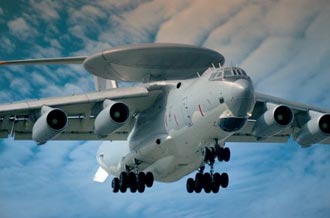China’s new airborne early warning and control systems (AWACS) are far more sophisticated than current US systems, according to a Washington-based think tank.
The Chinese-developed phased array radar technology embodied in the PLA Air Force’s KJ-2000 and KJ-200 AWACS systems is already a full generation ahead of the US E-3C and E-2C AWACS systems, according to a report by the Washington-based Jamestown Foundation.
Phased array radars — also known as active electronically-scanned arrays (AESAs) — allow ships and aircraft to broadcast powerful radar signals while remaining stealthy because the signals are broadcast in a variety of wavelengths, making them hard to distinguish from background noise.
China’s radar technology has advanced to the point that it is only the fourth nation to export its AWACS systems, after the US, Sweden and Israel. It was the successful efforts by the US in 2000 in pressurong Israel and Russia not to export AWACs technology to China that prompted Beijing to embark on an intensive effort to develop advanced homegrown radar technology.
Only when the KJ-2000 entered service in 2005 did China posses the capability to coordinate its air force in large-scale air battles while simultaneously tracking many enemy aircraft and ships. However, China was limited by the number of large Russian IL-76 planes it was able to deploy as the platform for KJ-2000s after Russia substantially raised their price tag despite an earlier contract.
The issue was eventually resolved in 2011 with an agreement to let them be built inside China. Meanwhile, China began using its smaller homegrown Shaanxi Y-8 cargo planes as the platforms for a more basic AWACS system dubbed the KJ-200. At the moment China is believed to have 4 KJ-2000s and an unknown number of KJ-200s.
Beijing is already at work on more advanced AWACS with the capability to detect the US F-22 and F-35 stealth fighters, according to a CCTV interview with Wang Xiaomo, chief designer of KJ-2000. Wang is known as “the father of China’s radar systems.”
Superior radar systems allow missiles to be fired preemptively to shoot down enemy aircraft before they can respond in kind. However, the miniscule radar signatures of US stealth jets — comparable to that of a bumblebee — make early detection by even advanced systems highly unreliable. Stealth planes have so-many radar-baffling features that the pilot’s helmet is often the most radar-visible object. F-22 pilots are encased in a cockpit designed to eliminate the radar signatures of their helmets.


